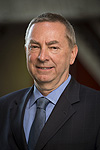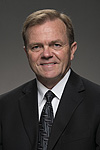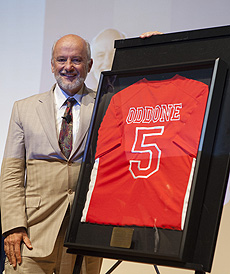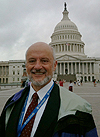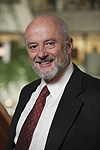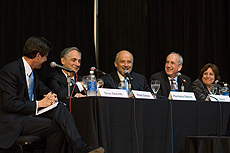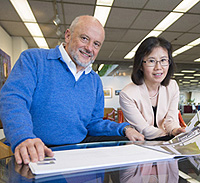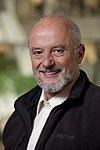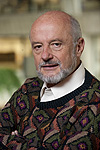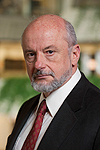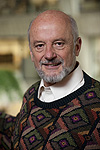|
Fermilab Director's Corner Archive |
| Subscribe | Contact Fermilab Today | Archive | Classifieds |
Every Tuesday, a new Fermilab Director's Corner appears in Fermilab Today, Fermilab's daily email publication for employees, users and subscribers.
Fermilab Director's Corner Archive – 2013
| December 17, 2013 |
| Recognizing accomplishments, part 2 |
|---|
|
With the end of the year upon us, I would like to continue to acknowledge the hard work and progress on many key lab projects and initiatives that happened in 2013. The Dec. 3 Director's Corner highlighted successes and milestones from the accelerator and operations sectors; this week, we focus on the particle physics and computing sectors. Congratulations to all of you for the following accomplishments: Making excellent progress on the construction of the NOvA and MicroBooNE experiments, which will lead to first data for each in mid-2014. |
| December 03, 2013 |
| Recognizing accomplishments |
|---|
|
With 2013 coming to a close, I'd like to take this opportunity to acknowledge a few of the lab's major accomplishments over the past 12 months. It has been a challenging year for us on many fronts, yet because of your continued focus and determination, Fermilab continues to make considerable progress on key projects and achieve many milestones. I look forward to celebrating the year's achievements with all staff and users at Friday's labwide party, starting at 4:30 p.m. in the Wilson Hall atrium. This week I highlight successes from the accelerator and operations sectors. Achievements from the particle physics and computing sectors will be the focus of my Dec. 17 corner. |
| November 19, 2013 |
| Meeting challenges together |
|---|
|
My primary goal as laboratory director is to ensure that Fermilab is functioning at the highest level possible, with all of its scientific and operational aspects working together effectively. Achieving that goal over the next decade will require us to work together to overcome two big challenges: managing several construction projects while operating the country's largest accelerator complex and carrying out these activities within an atmosphere of continuing fiscal restraint. The community has recognized our skill and expertise and has entrusted us with some of their most important scientific projects. |
| November 5, 2013 |
| P5 at Fermilab |
|---|
|
While this would normally be a "bye week" for my column, I wanted to take the chance to inform the entire laboratory community about this past weekend's meeting of the Particle Physics Project Prioritization Panel (P5). The panel, chaired by Steve Ritz from UC Santa Cruz, is charged with developing an updated strategic plan for the United States that can be executed over a 10-year period in support of a 20-year global vision for the field. The Fermilab-hosted P5 meeting, the first of three open meetings for the panel, focused on input from the 2013 Snowmass meeting, neutrino research and the international particle physics environment. |
| October 29, 2013 |
| Planning the future |
|---|
|
The first public meeting of the newest incarnation of the Particle Physics Project Prioritization Panel — known informally as P5 — will take place this weekend at Fermilab. Our lab is honored to be the first to host the panel, which has been charged by DOE and NSF with developing an updated strategic plan for U.S. high-energy physics under various budget scenarios. The P5 process is critically important for Fermilab as it will guide the focus of HEP project funding for the next decade. This weekend's meeting will focus on neutrino physics, Snowmass and the international context. The panel will hear from particle physics leaders in Europe (CERN, Italy and the UK), Asia (China and Japan) and Brazil. |
| October 15, 2013 |
| Moving forward despite uncertainty |
|---|
|
I start today's column by expressing my appreciation for the commitment you are exhibiting in the face of continuing uncertainty. These are unprecedented times for the laboratory, and your focus on carrying out our scientific mission is commendable. The budgetary situation has not changed from that described in my email on Friday: Congress has not yet appropriated funds for the fiscal year that began Oct. 1, and while we have been continuing to operate at a reduced level on carryover funding, we have begun to prepare for the possibility of a temporary lab shutdown and furloughs. No date has yet been set for the start of a temporary shutdown; I will let you know as soon as possible if such a shutdown may need to be implemented. |
| October 01, 2013 |
| Organizational changes |
|---|
|
As you are aware, our Chief Operating Officer Jack Anderson will be leaving Fermilab; his last day will be Friday, Oct. 4. In his 14 months here, Jack has performed admirably as COO and associate laboratory director (ALD) for operations. He made considerable progress in moving the laboratory forward, most notably in the contractor assurance and project management areas. I wish him well in his new position as deputy director for operations at Brookhaven National Laboratory. As many of you heard me say during my first week at Fermilab, organizational changes will be necessary to best position our lab to meet its future challenges. The first step in this reorganization takes place this Friday, when two individuals will separately step into the COO and ALD for operations positions. |
| September 17, 2013 |
| My first two weeks |
|---|
|
My goal over the last two weeks as the new director was to interact with as many members of the Fermilab staff and user community as possible. Many of you attended the seven "all hands" meetings, and I thank you for your helpful questions, comments and suggestions. I spent much of the time getting to know the laboratory, from a weekend visit with the operators in the Main Control Room to a tour of the impressive Lederman Science Center. I am still talking about how our education program is a model that should be copied nationally as our nation strives to encourage young students to enter science and engineering careers. I toured Fermilab's Fire Department and met a dedicated team of professionals who stand prepared to assist the laboratory in times of need. (I didn't drive a fire engine … yet.) |
| September 3, 2013 |
| Beginnings |
|---|
|
It is a privilege to be here on my first day as director of this great laboratory. My philosophy as I start my tenure is to develop and build on the platform of opportunities that you have constructed. This laboratory boasts tremendous talent, and there is a very rich menu of possibilities for us to apply our strengths to solve big scientific questions. Over the summer I have spoken to many different people and have heard overwhelming enthusiasm for the future of Fermilab and for the future of particle physics. There are great questions to be answered and new accelerator, detector and data analysis techniques needed to address them. The physics community will be debating the priorities of these questions and initiatives as part of the P5 process, and I am anxious to hear your views. |
| August 27, 2013 |
| FermiWorks: modernizing the business of Human Resources |
|---|
|
One of the key strategies highlighted in the Strategic Fermilab Agenda is streamlining and modernizing business processes to better support the laboratory’s mission and goals. Many of our current processes are paper-based and manual. Many of our information systems have not been refreshed in years. Modernizing will create a more efficient workplace for us all and will allow us to support our science mission more cost effectively. A cornerstone of our modernization roadmap is updating how we manage human resources and carry out the electronic functions associated with our workforce. The lab has chosen a cloud-based product called Workday to support this modernization. The first phase of implementation of our new system, called FermiWorks, is underway and will go live in early 2014. |
| August 20, 2013 |
| ASTA gains momentum |
|---|
|
Over the last month there have been a number of encouraging developments related to Fermilab’s plans for the Advanced Superconducting Test Accelerator (ASTA) at the New Muon Lab (NML) building. Fermilab recently hosted its first ASTA Users’ Meeting. The interest displayed at this meeting went beyond our expectations. Eighty-four potential users—two-thirds of whom were from institutions outside of Fermilab—attended the meeting to present and discuss 24 proposals for experimental programs that could be carried out at ASTA. Attendees included researchers from universities, national laboratories and industry. Held concurrently with the Users’ Meeting was the first meeting of the ASTA Program Advisory Committee (PAC), chaired by Gerry Dugan from Cornell University. |
| August 13, 2013 |
| A standing ovation |
|---|
|
July 30 marked a major milestone for the laboratory, when the Main Injector welcomed its first protons in more than a year. I congratulate the hundreds of employees and subcontractors who spent the last 15 months upgrading, repairing, overhauling and maintaining the laboratory's entire accelerator complex. From the new proton source at the very beginning to the NuMI beamline that generates neutrinos destined for Minnesota, nearly every single piece of the intricate chain of Fermilab accelerators has received close attention from our outstanding upgrade team. The team spanned many Fermilab groups, departments and divisions. Employees in the Accelerator Division put in countless hours upgrading the accelerator complex, and nearly every member of the division was involved with the upgrade. |
| August 6, 2013 |
| Planning meetings with DOE leadership |
|---|
|
Last week I spent three days in Washington, D.C., meeting with DOE officials on a variety of topics. Of primary importance was a meeting in which invited national laboratory representatives, including myself, had the pleasure of hosting Secretary Moniz and two new members of his staff: David Klaus, deputy undersecretary for management and performance, and Melanie Kenderdine, executive director for energy policy and systems analysis. During our meeting, Secretary Moniz elaborated on several of his key management initiatives. First, he is quickly embarking on preparing a new comprehensive strategic plan that will establish Department of Energy priorities and also help inform planning for the FY15 budget. This effort is just beginning, and Moniz has already requested input from the laboratory directors on key themes to include in the planning. |
| July 30, 2013 |
| Partnerships and technology transfer |
|---|
|
Fermilab's mission revolves around producing new knowledge through science, and the results can affect society in a considerable way. For instance, our partnerships with universities and industry have produced tangible innovations that enrich the lives of people around the globe: contributions to cancer therapy, the design of accelerators that may help reduce greenhouse gas emissions and advances in horticulture, to name a few. As we look to the future, partnerships and technology transfer will become even more important to the success of Fermilab. The new Illinois Accelerator Research Center will provide an especially exciting—and challenging—opportunity to explore more efficient and effective partnering methods. |
| July 23, 2013 |
| Department of Energy restructuring |
|---|
|
Last week Energy Secretary Ernest Moniz announced a restructuring of DOE's leadership. The plan makes significant changes that will affect Fermilab, so in today's column I will take you through some of the highlights. If you'd like to hear about the changes directly from Secretary Moniz, I encourage you to watch the video of his town hall meeting for DOE employees. The first major change that will affect our lab is the merging of the two existing undersecretary positions for science and energy. The new undersecretary for science and energy will oversee the Office of Science—our home within DOE—as well as the five energy offices. Most of DOE's national labs will fall under this new undersecretary. The merged structure will allow science and energy research to be better coordinated within DOE. |
| July 16, 2013 |
| Strategic lab agenda |
|---|
|
At Fermilab we must effectively and efficiently align scientific research efforts to meet our customers' and collaborators' most critical needs while building capabilities to meet future lab requirements. These demands are complicated by inevitable resource constraints that raise challenges—the most critical being the alignment of plans and budgets to support our future. To address this challenging environment, we have developed a comprehensive, labwide strategic agenda to help organize internal strategy discussions and priority-setting. The agenda provides a framework for an integrated, five-year plan that supports the three frontiers of particle physics along with the facilities and operational capabilities needed to ensure success. |
| July 9, 2013 |
| A time of change |
|---|
|
Last week I found myself in the unique position of being afforded the distinction of serving as interim laboratory director between Pier Oddone's retirement and the beginning of Nigel Lockyer's tenure on Sept. 3. With Young-Kee Kim's return to her full-time position in the Physics Department at the University of Chicago, I had the sudden feeling of being on a sailboat when the wind just … stops. It can be an eerie feeling, but sail we must, and the wind will gradually return. As we look to the immediate future, it is important for us as individuals—and as a laboratory—to maintain a clear focus on the business of Fermilab. Until Nigel begins in September, I will maintain our forward momentum on the plan and activities that Pier and Young-Kee set in place. I plan no structural changes during this transition period. |
| June 25, 2013 |
| Thanks for eight great years |
|---|
|
After eight years and about 400 director's corners, I come to the last column of my tenure as director of our great laboratory. I am deeply grateful for the privilege to have served as your director and for the support, encouragement and great devotion of all of you to Fermilab's mission. You are hard-charging, can-do folks. Often you start with a healthy dose of skepticism—you need to be convinced. But watch out when you move! There is no stopping you until you succeed. When I was considering taking the helm of Fermilab more than eight years ago, I remember hearing from a colleague familiar with the lab, "There is a lot of juice there." Indeed I found "a lot of juice" here. It consists of vitality and strength joined with incredible resilience, which has allowed us to deal successfully with a major transition from the dominant Tevatron program to a marvelous suite of new projects that delve into the greatest mysteries of the universe—projects that keep Fermilab and the U.S. program at the forefront of particle physics. And all of this has been accomplished despite bruising budgetary circumstances. |
| June 18, 2013 |
| Last rounds in Washington |
|---|
|
These days, as I near the end of my tenure at Fermilab, I find myself finishing up this and doing the last of that. It is no different with my interactions in Washington. Last week the Fermilab senior leadership had its yearly planning meeting with the Office of Science. The meeting, presided by Office of Science Deputy Director Pat Dehmer and attended by the associate directors of all the Office of Science programs, is a very important one for our laboratory. We present and discuss the state of the lab and our plans and initiatives of the entire spectrum of laboratory activities. Pat Dehmer was complimentary of the presentation, but she emphasized that our plans are very ambitious and that we have to execute them perfectly in every aspect if we want to see the projects through. She explained that even simpler facilities than LBNE and Project X are difficult to execute in the current environment. |
| June 11, 2013 |
| The three frontiers of particle physics |
|---|
|
The success of "Abenomics" in Japan has made the legend of the three arrows known around the world. Japanese Prime Minister Shinzo Abe has based his economic policies on three thrusts: monetary expansion, fiscal spending and structural reform. He calls this his three arrows program in reference to a sixteenth century legend from his family's region of the country. Any one of these thrusts would not right Japan's economy by itself and could be easily derailed. Together they have had a remarkable impact on the Japanese economy, apparently awakening it after a long slumber. There is even a line of lingerie with the "three arrows" and "Abenomics" theme that celebrates this awakening [link TK]. |
| June 04, 2013 |
| Restarting and reaching out |
|---|
|
As June begins, we continue to make excellent progress on preparing for the restart of the full Fermilab accelerator complex and the experiments that will use our new, more powerful beams of protons and neutrinos. Today's Fermilab Today feature article describes the details of the heroic efforts by the Accelerator Division over the past year to prepare the Main Injector, Recycler and NuMI beamline to deliver proton beams at double the power. I also want to commend the efforts of the many employees across all divisions, sections and centers that have made essential contributions to the completion of this major project that truly brings us into the Intensity Frontier era. |
| May 21, 2013 |
| Big Science: Big Challenges |
|---|
|
On Thursday evening, the seventh in the series of joint events organized by the University of Chicago, Argonne and Fermilab took place at the Museum of Science and Industry in Chicago. The event brought together scientists, engineers and faculty members of the three institutions. The venue was the museum rotunda, a spectacular setting for an event on big science. After a short introductory video, 300 attendees listened to a vibrant discussion on "Big Science: Big Challenges," followed by many questions from the audience. The moderator, Steve Edwards, who is an experienced journalist, well-known radio host and the current deputy director of the Institute of Politics of the University of Chicago, did a great job moderating the discussion. |
| May 14, 2013 |
| The future of Fermilab |
|---|
|
Two important events related to the future of Fermilab occurred last week. On Wednesday, Fermilab held a groundbreaking for the building that will house the Muon g-2 experiment. Nearby, an additional building and associated beamline will be built to house, initially, the Mu2e experiment. These two experiments will be located between the former antiproton source—now repurposed to produce muon beams—and the central campus. When completed, this area of the Fermilab site will be referred to colloquially as the muon campus and will join our other areas for neutrino physics, engineering and technical areas, and test beam areas. We are formulating a broader view of how the Fermilab site should develop over the next several decades as part of a comprehensive master plan for the site. |
| May 07, 2013 |
| Treasuring history |
|---|
|
Last Saturday I attended the Pre-Fermilab Tenant Picnic, more familiarly referred to as the Farmer's Picnic. For many years now, this event has brought together the families that farmed the land around Fermilab for generations before the lab was established. As with many events at Fermilab, former and current lab employees volunteer their time to organize the picnic. Some of the employees are related to the farm families, and all treasure the opportunity to share good food and, more importantly, stories about the land and the times before the laboratory was established. Over the years employees of the laboratory who also grew up on the farms before the lab was established have attended the picnics. They provide historical continuity and narratives of how the landscape has changed—and also not changed—under Fermilab's stewardship. |
| April 23, 2013 |
| Progress on NOvA |
|---|
|
Last week, the NOvA collaboration held a vibrant meeting at Fermilab. The construction of NOvA is going well: Production and assembly rates are encouraging, leading us to believe that we will be able to complete the detector on budget and on schedule. This goal is important for the laboratory since we need to establish excellence in project management given the number of projects that are ahead of us. If we continue on track, NOvA will be the third project in a row that we have completed on budget and on schedule. This was not the situation last fall when the contingency did not appear adequate to finish the job. The laboratory took many steps to up our game, control contingency and complete ongoing work well within expected cost parameters. |
| April 16, 2013 |
| Our first FY14 budget news |
|---|
|
Before I talk about the laboratory budget, I want to express sympathy on behalf of our lab for the victims of yesterday's bombings and their families. Our thoughts are with them. The President's Budget Request for FY2014 was unveiled last week. This is the first step in the annual federal budget cycle and gives us a good idea of what we can expect for next year's budget. The request contains essentially flat funding for our base scientific program, with a much-needed one-time allocation of funds for improvements to our utility systems. We have a momentous year ahead with the restart of our accelerator complex and the development and construction of many new projects. This budget, while constrained, allows us to make steady progress and improve the foundation for our future. |
| April 09, 2013 |
| Safety update |
|---|
|
Perennial awareness is crucial to maintaining a safe environment. All of us can contribute to this state of mind. I try to do this in several ways, including writing about safety periodically in this column. Today I am pleased to be able to bring you good news on the safety front. The rate of recordable accidents has dropped by a factor of two from this point last year. Even more importantly, the rate of injuries that required either time away from work or restricted work is the lowest ever. If we maintain the same performance for the second part of the year, we will have a record low number of DARTS and TRCs for the year. Kudos to all of you for your efforts to keep yourselves and your colleagues safe. Keep up the fine performance! |
| April 02, 2013 |
| A busy week |
|---|
|
Last week went by like a flash with two important reviews taking place at the laboratory. The first was a one-of-a-kind review organized by Fermilab on how we manage projects—those both under way and in the planning stages—and what we can do to improve our practices in the very complex environment in which we operate. For this review, we were fortunate to have participating some outstanding folks who are very successful managers of large projects within the DOE system. They brought a wealth of experience and provided valuable advice on where we should focus, which will help us to deliver projects successfully. |
| March 26, 2013 |
| An FY13 budget |
|---|
|
Last Thursday Congress passed the Consolidated and Further Continuing Appropriations Act of 2013, which funds the federal government for the rest of this fiscal year. For the Department of Energy's Office of Science, which funds Fermilab, the act essentially allocates the same budget as the 2012 fiscal year. Once sequestration is applied, the Office of Science will receive approximately 5 percent less than it did last year. What does that mean for Fermilab? The Office of High Energy Physics has given us an estimate of our final budget for this fiscal year—approximately $368 million, 9 percent lower than last year. The reason we get a larger-than-average cut relative to the continuing resolution is that, under the President's budget request for FY13, we had already been cut to an expected $375 million. |
| March 19, 2013 |
| HEPAP meeting |
|---|
|
The High Energy Physics Advisory Panel, which advises the Department of Energy and National Science Foundation, met in Maryland last week. The panel's two days of discussion covered many important topics, including the draft European Strategy and the report from the Facilities Subpanel charged by HEPAP to classify large high-energy physics facilities proposed to be built or upgraded over the next 10 years. The European Strategy identifies long-baseline neutrino oscillation experiments as one of the four high-priority global programs. The draft strategy encourages European scientists to explore collaborating with experiments in the United States and Japan. We hope that European groups' strong interest in liquid-argon time projection chamber technology will lead them to work with LBNE. |
| March 12, 2013 |
| Projects Inc. |
|---|
|
We are in the process of re-establishing a competitive world-class scientific program after the closure of the Tevatron. This means building several projects at once while at the same time operating the largest accelerator complex in the United States and carrying out physics research across all three frontiers of particle physics. We completed our recent projects MINERvA and DECam on schedule and under budget. Also, we are committed to finishing NOvA on schedule and on budget. While we ultimately achieve the desired outcomes, we do so with much unnecessary drama, alarming us and more importantly our funders along the way, as happened recently with the NOvA construction. |
| March 05, 2013 |
| ICFA meeting |
|---|
|
The International Committee on Future Accelerators that I chair met at the TRIUMF laboratory in Vancouver, Canada on February 21st and 22nd. ICFA meets twice a year, with the directors of all the world’s principal accelerator laboratories joining for the winter meeting. This particular meeting was very well attended because it marked a special occasion: the official joining of the International Linear Collider and Compact Linear Collider efforts into the new Linear Collider Board. All senior leaders in the new Linear Collider organization have been appointed and will guide continuing work on the two projects over the next few years. The ICFA meeting also celebrated another major linear collider milestone: the completion of the technical design report (TDR) for the ILC. |
| February 26, 2013 |
| Sequestration and Fermilab |
|---|
|
Sequestration has been all over the news in recent weeks. Automatic cuts to federal government spending will take effect on Friday if Congress does not take action before then. The cuts have the potential to do much harm across all sectors of our society, from fire protection to air traffic control and from preschools to scientific research. Like many of you, I am very concerned about the effect these cuts will have on our laboratory. I wish that I were able to detail exactly what will happen at Fermilab; however, as the federal government is operating under a temporary budget that expires on March 27, it is not clear to what budget the cuts will be applied. That leaves a situation so murky that no one is able to say for certain what our lab's budget will be for the rest of this year. |
| February 19, 2013 |
| FRA Board meeting |
|---|
|
Last week, the FRA Board of Directors met at Fermilab. The FRA Board is the highest authority in FRA and is responsible for delivering on Fermilab's contract with DOE. It appoints the laboratory director and oversees the laboratory in its operations, strategic planning and the relations with its many stakeholders. Board committees delve deeper into their respective areas of expertise, including ES&H, audit, administration and finance, compensation, physics and science planning. The board also convenes additional external review committees that focus on specific areas, including the lab's scientific programs and the implementation of our contractor assurance system. The meetings of the board are always interesting and useful. Last week's meeting included discussions of two important and timely issues. |
| February 12, 2013 |
| Fermilab's accelerator program |
|---|
|
Last week our Accelerator Advisory Committee conducted a three-day review of Fermilab's accelerator program. The committee recognized the tremendous progress we have made since last year's review and provided valuable feedback on our future projects. We are fortunate to have an outstanding committee that brings together the expertise of many laboratories and universities to provide input on our extensive program. Below is a brief survey of many of the projects currently under way. The Advanced Superconducting Test Accelerator (ASTA) is a proposed accelerator R&D facility that will be important for the development of future high-energy and high-intensity machines. ASTA's SRF linac and small associated ring would put to immediate use the considerable investment made in ILC components and SRF development at Fermilab. |
| February 05, 2013 |
| Updating the European Strategy for Particle Physics |
|---|
|
Last week the first draft of the updated European Strategy for Particle Physics was made public. This document, which remains a draft until reviewed and approved by the CERN Council in May, guides our European colleagues in their exploration and development of the field of particle physics. It is an update of the very first European strategy, originally developed in 2006. The update process, led by the European Strategy Group, has been long and inclusive. The group includes representatives of all of the CERN member countries and participation from countries with other types of formal agreements to CERN—including the United States—and the rest of the international particle physics community. Over the past year and a half, the group has solicited many discussion papers. It also held a community workshop that brought together 500 physicists to seek input and discuss the many issues and opportunities ahead for particle physics. U.S. and Fermilab physicists contributed to both efforts. A Preparatory Group worked hard to summarize the current state of our field and future opportunities in its briefing book, used by the Strategy Group to draft the updated strategy. |
| January 29, 2013 |
| URA Council of Presidents |
|---|
|
The annual meeting of the Council of Presidents of the Universities Research Association took place last Wednesday in Washington, D.C. URA and the University of Chicago partner to form the Fermi Research Alliance, which operates our laboratory for the Department of Energy. The annual meeting, which attracts top-level representatives from each of URA's 86 member universities, serves as a business meeting for the association and a forum for discussion of science policy and of the role of particle physics research in the United States. Invited speakers at the URA meeting included Office of Science Director Bill Brinkman, who spoke of his strong support for LBNE; our Congressional representative Randy Hultgren, who communicated his strong support for science research in the national agenda; Congressman Bill Foster, who represents the 11th Congressional district that includes Argonne National Laboratory and who demonstrated his command of particle physics; and NASA's John Grunsfeld, associate administrator for the agency's Science Mission Directorate, who presented the vast NASA science program. |
| January 22, 2013 |
| A great physics briefing book |
|---|
|
This week the European Strategy Group meets in Erice, Italy, to formulate an updated European strategy for particle physics. The last European strategy document was summarized in two pages back in 2006 and established the physics goals of the European program and the R&D necessary for future machines. Since then much has changed. The LHC has come into its own with outstanding performance and a huge discovery under its belt. It is clearly the machine that will dominate the Energy Frontier for the next two decades. The discovery of what we expect to be the Higgs boson is a triumph for particle physics and gives us a totally new particle to study: the first fundamental particle without spin. |
| January 15, 2013 |
| Making our projects a success |
|---|
|
Leadership at the Intensity Frontier of particle physics doesn't just mean more particles for our experiments, it also means more projects for our laboratory. Because each individual Intensity Frontier experiment only tells part of the scientific story, a suite of experiments is needed to fully explore the landscape of new physics. For us to succeed as a laboratory in this new era we must become very good at managing and delivering projects on budget and on schedule. Any one project that does not deliver on its goals can affect adversely our ability to obtain additional projects. We completed our last two projects, MINERvA and DECam, on budget and on schedule, fully meeting or exceeding their technical specifications. The much larger NOvA project is now nearing completion. From a technical standpoint, NOvA is progressing extremely well. |
| January 08, 2013 |
| At the start of 2013 |
|---|
|
This year should be an exciting one for the laboratory and for particle physics. At Fermilab, we will have new data as our accelerators turn back on at higher power. NOvA will see its first particles, the Dark Energy Survey will begin and many of our new projects—IARC, LBNE and Muon g-2, among others—will take big steps forward over the next 12 months. Of course, building and operating projects require funding, and the federal government continues to struggle with two major interrelated issues that affect us: sequestration and this year's federal budget. The new year brought a much-publicized agreement by Republicans and Democrats that avoided raising taxes on the vast majority of taxpayers but also simply postponed by two months the deadline for sequestration, which would result in cuts to current budgets. |
Director's Corner - Current Archive
2014 Director's Corner Archive
2013 Director's Corner Archive
2012 Director's Corner Archive
2011 Director's Corner Archive
2010 Director's Corner Archive
2009 Director's Corner Archive
Return to Current Fermilab Today
